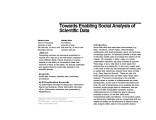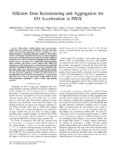|
|
Creator | Title | Description | Subject | Date |
| 1 |
 |
Hansen, Charles D. | Accelerated isosurface extraction in time-varying fields | For large time-varying data sets, memory and disk limitations can lower the performance of visualization applications. Algorithms and data structures must be explicitly designed to handle these data sets in order to achieve more interactive rates. The Temporal Branch-on-Need Octree (T-BON) extends t... | Isosurfaces; Time-dependent scalar field visualization; Multiresolution methods; Octree; Bricking; Unstructured grid visualization; Out-of-core visualization | 2000 |
| 2 |
 |
Freire, Juliana | Managing XML data: an abridged overview | XML's flexibility makes it a natural format for both exchanging and integrating data from diverse data sources. In this survey, the authors give an overview of issues in managing XML data, discuss existing solutions, and outline the current technology's open problems and limitations. | XDM | 2004-07 |
| 3 |
 |
Freire, Juliana; Silva, Claudio T. | Towards enabling social analysis of scientific data | Flickr, Facebook, Yahoo! Pipes), which facilitate collaboration and sharing between users, are becoming increasingly popular. An important benefit of these sites is that they enable users to leverage the wisdom of the crowds. For example, in Flickr, users, in a mass collaboration approach, tag ... | Social data analysis; Scientific data; Workflows; Provenance; Pipelines; VisTrails | 2008 |
| 4 |
 |
Hansen, Charles D. | Isosurface extraction in time-varying fields using a temporal branch-on-need tree (T-BON) | The Temporal Branch-on-Need Tree (T-BON) extends the threedimensional branch-on-need octree for time-varying isosurface extraction. At each time step, only those portions of the tree and data necessary to construct the current isosurface are read from disk. This algorithm can thus exploit the tempor... | Isosurfaces; Time-dependent scalar field visualization; Octree; Multiresolution methods | 1999 |
| 5 |
 |
Pascucci, Valerio; Swank, William Lorenzo | Scalable scientific data | Question Hierarchial Z-Order Evaluation How can we present hundreds or thousands of gigabytes of scientific data to a user for analysis and interpretation? • The Scientific Computing and Imaging Institute is responsible for helping scientists visualize massive amounts of data. • Sources ... | | 2010-02-26 |
| 6 |
 |
Freire, Juliana | Provenance in scientific workflow systems | The automated tracking and storage of provenance information promises to be a major advantage of scientific workflow systems. We discuss issues related to data and workflow provenance, and present techniques for focusing user attention on meaningful provenance through "user views," for managing the ... | Workflow systems; Provenance | 2007 |
| 7 |
 |
Hansen, Charles D.; Chien, Chi-Bin | Interactive visualization tool for multi-channel confocal microscopy data in neurobiology research | Confocal microscopy is widely used in neurobiology for studying the three-dimensional structure of the nervous system. Confocal image data are often multi-channel, with each channel resulting from a different fluorescent dye or fluorescent protein; one channel may have dense data, while another has ... | Volume rendering; Zebrafish | 2009-11 |
| 8 |
 |
Freire, Juliana | Introducing the VisTrails Provenance Explorer Plugin for ParaView | In order to analyze and validate various hypotheses, it is necessary to create insightful visualizations of both the simulated processes and observed phenomena, using powerful data analysis and visualization tools like ParaView. But to explore data through visualization, scientists need to go thro... | VisTrails; Provenance; ParaView | 2009 |
| 9 |
 |
Davis, Alan L. | Data driven nets: a maximally concurrent, procedural, parallel process representation for distributed control systems | A procedural parallel process representation, known as data-driven nets is described. The sequencing mechanism of the data-driven representation is based on the principle of data dependency. Operations are driven into action by the arrival of the required working set of input operands. Execution of ... | Data driven nets | 1978 |
| 10 |
 |
Brunvand, Erik L. | Low latency self-timed flow-through FIFOs | Self-timed flow-through FIFOs are constructed easily using only a single C-element as control for each stage of the FIFO. Throughput can be very high in this type of FIFO as the communication required to send new data to the FIFO is local to only the first element of the FIFO. Circuit density can ... | | 1995 |
| 11 |
 |
Gopalakrishnan, Ganesh | Timing constraints for high speed counterflow-clocked pipelining | With the escalation of clock frequencies and the increasing ratio of wire- to gate-delays, clock skew is a major problem to be overcome in tomorrow's high-speed VLSI chips. Also, with an increasing number of stages switching simultaneously comes the problem of higher peak power consumption. In our ... | Timing constraints; clock frequencies; clock skew; high-speed; VLSI chips; counterflow-clocked pipelining | 1995 |
| 12 |
 |
Hansen, Charles D. | Fast data parallel polygon rendering | This paper describes a data parallel method for polygon rendering on a massively parallel machine. This method, based on a simple shading model, is targeted for applications which require very fast rendering for extremely large sets of polygons. Such sets are found in many scienti c visualization ap... | | 1993 |
| 13 |
 |
Pascucci, Valerio | Efficient data restructuring and aggregation for I/O acceleration in PIDX | Hierarchical, multiresolution data representations enable interactive analysis and visualization of large-scale simulations. One promising application of these techniques is to store high performance computing simulation output in a hierarchical Z (HZ) ordering that translates data from a Cartesian ... | | 2012-01-01 |
| 14 |
 |
Brunvand, Erik L. | Reduced latency self-timed FIFO circuits | Self-timed flow-through FIFOs are constructed easily using only a single C-element as control for each stage of the FIFO. Throughput can be very high in FIFOs of this type because new data can be sent to the FIFO after communicating locally with only the first element of the FIFO. Therefore the thro... | FIFO circuits; Self-timed; Flow-through; Reduced latency | 1994 |
| 15 |
 |
Pugsley, Seth H; Spjut, Josef Bo; Nellans, David W; Balasubramonian, Rajeev | SWEL: hardware cache coherence protocols to map shared data onto shared caches | In chip multiprocessors, replication of cache lines is allowed to reduce the latency each core has to access a cache line. Because of this replication, it is possible for one copy of data to become out of date if another copy of that data is modified. How a MESI protocol accomplishes this: ? K... | | |
| 16 |
 |
Hansen, Charles D. | Semotus visum: a flexible remote visualization framework | By offering more detail and precision, large data sets can provide greater insights to researchers than small data sets. However, these data sets require greater computing resources to view and manage. Remote visualization techniques allow the use of computers that cannot be operated locally. The S... | Remote visualization; Semotus Visum | 2002 |
| 17 |
 |
Kniss, Joe; Riesenfeld, Richard F. | Visual summary statistics | Traditionally, statistical summaries of categorical data often have been visualized using graphical plots of central moments (e.g., mean and standard deviation), or cumulants (e.g., median and quartiles) by box plots. In this work we reexamine the box plot and its relatives and develop a new hyb... | Visual summary statistics; categorical data; box plot; hybrid summary plot | 2007 |
| 18 |
 |
Parker, Steven G.; Hansen, Charles D. | Distributed interactive ray tracing for large volume visualization | We have constructed a distributed parallel ray tracing system that interactively produces isosurface renderings from large data sets on a cluster of commodity PCs. The program was derived from the SCI Institute's interactive ray tracer (*-Ray), which utilizes small to large shared memory platforms, ... | Ray tracing; Volume rendering; Large data; Cluster computing; Distributed shared memory | 2003 |
| 19 |
 |
Henderson, Thomas C. | An approach to three-dimensional scene databases | Current image database research is concerned for the most part with the encoding and processing of two-dimensional images. However, the most successful approach to computer vision is based on 3-dimensional information, organized as either stacks of 2-D images (e.g., the intrinsic images of Barrow an... | Image databases; Three-dimensional; Scene databases | 1987 |
| 20 |
 |
Bhanu, Bir; Henderson, Thomas C. | Range data processing: representation of surfaces by edges | Representation of surfaces by edges is an important and integral part of a robust 3-D model based recognition scheme. Edges in a range image describe the intrinsic characteristics about the shape of the objects. In this paper we present three approaches for detecting edges in 3-D range data. The ap... | Range data; Edges; Recognition scheme; 3-D | 1985 |
| 21 |
 |
Pascucci, Valerio | Combining in-situ and in-transit processing to enable extreme-scale scientific analysis | With the onset of extreme-scale computing, I/O constraints make it increasingly difficult for scientists to save a sufficient amount of raw simulation data to persistent storage. One potential solution is to change the data analysis pipeline from a post-process centric to a concurrent approach based... | | 2012-01-01 |
| 22 |
 |
Freire, Juliana; Silva, Claudio T. | Scientific exploration in the era of ocean observatories | Society's critical and urgent need to better understand the world's oceans is amply documented and has led to a unique convergence of operational and scientific interests in the US, organized around the concept of ocean observatories: cyber-facilitated integrations of observations, simulations, a... | Ocean observatories; Provenance | 2008-05 |
| 23 |
 |
Hansen, Charles D. | Parallel volume rendering using binary-swap compositing | Existing volume rendering methods, though capable of very effective visualizations, are computationally intensive and therefore fail to achieve interactive rendering rates for large data sets. Although computing technology continues to advance, computer processing power never seems to catch up to th... | | 1994 |
| 24 |
 |
Hansen, Charles D. | Data distributed, parallel algorithm for ray-traced volume rendering | This paper presents a divide-and-conquer ray-traced volume rendering algorithm and a parallel image compositing method, along with their implementation and performance on the Connection Machine CM-5, and networked workstations. This algorithm distributes both the data and the computations to individ... | Volume rendering; Ray tracing; ; Computer algorithms; Scientific visualization; Network computing; Massively parallel processing | 1993 |
| 25 |
 |
Hansen, Charles D. | Massively parallel visualization: parallel rendering | This paper presents rendering algorithms, developed for massively parallel processors (MPPs), for polygonal, spheres, and volumetric data. The polygon algorithm uses a data parallel approach whereas the sphere and volume renderer use a MIMD approach. Implementations for these algorithms are presente... | Parallel visualization; Parallel rendering; Massively parallel processors | 1995 |

























